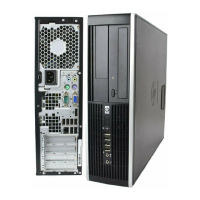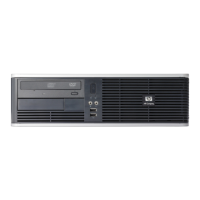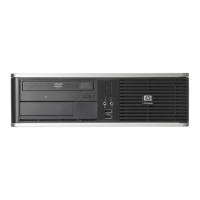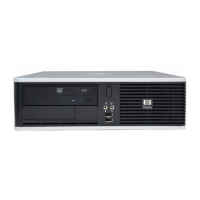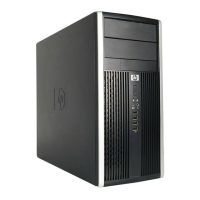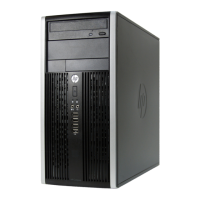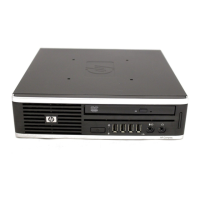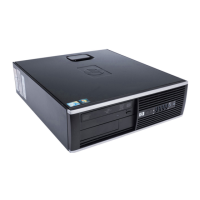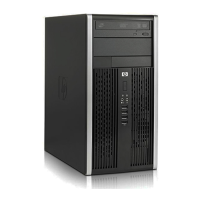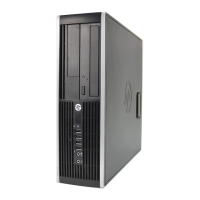
Do you have a question about the HP Compaq Pro 6300 Series Small Form Factor and is the answer not in the manual?
| Form Factor | Small Form Factor |
|---|---|
| Expansion Slots | 1 PCIe x16, 1 PCIe x1, 1 PCI |
| Processor | Intel Core i3/i5/i7 |
| Chipset | Intel Q75 Express |
| Memory | Up to 32 GB DDR3-1600 SDRAM |
| Storage | 128 GB Solid State Drive |
| Graphics | Integrated Intel HD Graphics |
| Optical Drive | DVD-ROM |
| Operating System | Windows 7, Windows 8, FreeDOS |
| USB Ports | 6 USB 2.0 |
| Ports | VGA, DisplayPort, RJ-45, Serial, PS/2, Audio in/out |
| Network | Integrated Intel 82579LM Gigabit Ethernet |
| Power Supply | 240W |
| Dimensions | 338 x 379 x 100 mm (13.3 x 14.9 x 3.9 in) |
| Weight | 7.6 kg (16.7 lbs) |
| Audio | Integrated HD audio |
Overview of general hardware and software features for MT and SFF models.
Details and labels for the front panel components of the Microtower PC.
Details and labels for the front panel components of the SFF PC.
Identifies and labels the rear panel connectors for the Microtower PC.
Identifies and labels the rear panel connectors for the SFF PC.
Explains where to find the serial and product ID numbers on the computer.
Guide to activating Windows 7 and customizing its settings.
Instructions for obtaining and installing Windows 7 operating system updates.
Steps for installing or updating device drivers for hardware components.
How to adjust monitor refresh rates, resolution, and color settings.
Guide to activating Windows 8 and customizing its settings.
Instructions for obtaining and installing Windows 8 operating system updates.
Overview of the functions and capabilities of the F10 Computer Setup utility.
Step-by-step guide on how to access and navigate the Computer Setup utility.
Details options within the File menu of Computer Setup, including system info and ROM flashing.
Configuration options for storage devices, including translation modes and boot order.
Security settings in Computer Setup, such as passwords and device security.
Power management options within Computer Setup, including OS and hardware power management.
Advanced configuration settings for users, covering boot options and device configurations.
Procedure for restoring system configuration settings from a saved backup.
Lists and illustrates spare parts for the Microtower chassis, categorized by component type.
Lists and illustrates spare parts for the SFF chassis, categorized by component type.
Explains the risks of ESD and precautions to prevent damage to components.
Precautions for handling electronic components to avoid static damage.
Details equipment and methods for personal grounding to prevent static discharge.
Precautions for preparing a static-free work area to prevent static damage.
Lists recommended materials and equipment for preventing static electricity.
General guidelines to prevent overheating and prolong computer life.
General procedures for maintaining the computer's condition.
Step-by-step instructions for cleaning the computer's external case.
Procedures for cleaning the keyboard, including under the keys.
Guidelines for safely cleaning the computer monitor screen and body.
Instructions for cleaning the mouse ball and body.
General considerations for computer disassembly and assembly.
Lists necessary tools and software for servicing the computer.
Information on screw types and the importance of using correct screws during reassembly.
Handling precautions for flat, flexible cables and connectors.
Handling precautions for hard drives, including shock, vibration, and static discharge.
Information about the computer's internal lithium battery and its handling.
Initial safety procedures and steps before disassembling the computer.
Instructions for removing and replacing the computer's access panel.
Steps for removing and replacing the front bezel of the Microtower chassis.
Instructions on how to install and use the security screw for the front bezel.
Procedure for removing bezel blanks to install drives in the drive bays.
Overview of memory modules (DIMMs) and their installation.
Detailed steps for installing memory modules into the DIMM sockets.
Information on installing and removing PCI and PCI Express expansion cards.
Identifies system board connectors and their corresponding components.
Lists various drive types and their spare part numbers.
Guidelines for connecting SATA optical drives, media card readers, and eSATA adapters.
Illustrates and identifies the locations of drive bays within the chassis.
Step-by-step instructions for removing optical drives and media card readers.
Instructions for installing optical drives and media card readers into drive bays.
Procedure for removing internal hard drives from their bays.
Steps for installing internal hard drives into the computer.
Instructions for removing and replacing the front fan assembly.
Steps for removing and replacing the front I/O assembly.
Procedure for removing and replacing the power switch and LED assembly.
Instructions for removing and replacing the processor heat sink.
Steps for removing and replacing the computer's processor.
Instructions for removing and replacing the internal computer speaker.
Procedure for removing and replacing the rear chassis fan.
Steps for removing and replacing the computer's power supply unit.
Instructions for removing and replacing the main system board.
Initial safety procedures and steps before disassembling the SFF computer.
Instructions for removing and replacing the SFF computer's access panel.
Steps for removing and replacing the front bezel of the SFF chassis.
Instructions on how to install and use the security screw for the SFF front bezel.
Procedure for removing bezel blanks to install drives in the SFF chassis.
Overview of memory modules (DIMMs) and their installation for SFF.
Detailed steps for installing SFF memory modules into the DIMM sockets.
Information on installing and removing PCI and PCI Express expansion cards in SFF.
Identifies SFF system board connectors and their components.
Lists various drive types and their spare part numbers for SFF.
Guidelines for connecting SATA drives and installing them in SFF.
Illustrates and identifies drive bay locations in the SFF chassis.
Step-by-step instructions for removing 5.25-inch drives from SFF bays.
Instructions for installing 5.25-inch drives into SFF drive bays.
Procedure for removing 3.5-inch drives from SFF bays.
Steps for installing 3.5-inch drives into SFF drive bays.
Detailed steps for removing and replacing the main internal 3.5-inch hard drive in SFF.
Instructions for removing and replacing the fan duct in the SFF chassis.
Steps for removing and replacing the front fan assembly in the SFF chassis.
Procedure for removing and replacing the hood sensor in the SFF chassis.
Steps for removing and replacing the front I/O and power switch/LED assembly in SFF.
Instructions for removing and replacing the internal speaker in the SFF chassis.
Procedure for removing and replacing the processor heat sink in the SFF chassis.
Steps for removing and replacing the processor in the SFF chassis.
General safety and comfort guidelines for working with the computer.
Steps to take before contacting HP support for assistance.
General suggestions for resolving common computer, monitor, or software issues.
Solutions for common issues like locked-up computers or incorrect date/time.
Troubleshooting steps for power-related issues like intermittent shutdowns or no power.
Solutions for issues related to hard drive errors, transactions, and recognition.
Troubleshooting steps for issues with media card readers and inserted cards.
Solutions for common display issues like blank screens or blurry video.
Troubleshooting steps for issues with sound output or recording.
Solutions for common printer issues like not printing or garbled output.
Troubleshooting steps for unresponsive or malfunctioning keyboards and mice.
Guidance for resolving issues when adding or removing hardware components.
Troubleshooting steps for network connectivity and Wake-on-LAN issues.
Solutions for issues related to memory installation or insufficient memory.
Troubleshooting steps for processor-related issues like overheating or improper installation.
Solutions for issues with CD-ROM or DVD drives not reading discs or booting.
Troubleshooting steps for issues with USB flash drives not being recognized or booting.
Solutions for problems with USB devices, headphones, or microphones connected to the front panel.
Troubleshooting steps for issues with connecting to the internet or web browser problems.
Solutions for issues related to application installation, configuration, or conflicts.
Lists and explains POST error codes and text messages encountered during startup.
Guide to understanding front panel LED and audible error codes for diagnostics.
Procedure for clearing or disabling setup and power-on passwords using a jumper.
Steps for clearing CMOS settings to restore factory defaults.
Explains the benefits and purpose of using HP's UEFI hardware diagnostics.
Instructions on accessing and initiating the UEFI hardware diagnostics.
Steps to download and prepare HP PC hardware diagnostics on a USB drive.
Procedures for backing up and restoring data and system files in Windows 7.
How to use System Restore to return the computer to a previous state.
Overview of System Recovery options for restoring the OS and factory software.
Steps to perform System Recovery when Windows 7 is operational.
Procedure for System Recovery when Windows 7 is unresponsive.
Information on creating and using recovery media for system restoration.
Step-by-step guide to creating recovery discs or USB flash drives.
Guide to using Windows 8 backup and restore features for data protection.
Instructions on backing up personal files, templates, and settings in Windows 8.
Steps for recovering the system using Windows recovery tools or f11 options.
How to use Windows recovery tools for information recovery and automatic repair.
Instructions for using the f11 key to perform system recovery from the original image.
Guidance on using Windows 8 media for system recovery if recovery partitions are unavailable.
Information about the Smart Cover FailSafe Key for unlocking the computer cover.
Steps to contact HP or visit the website to order a FailSafe Key.
Procedure for using the FailSafe Key to remove tamper-proof screws securing the lock.
Applicable requirements for power cord sets in all countries.
Specific power cord requirements for use in Japan.
Additional requirements for power cord sets specific to various countries.
Technical specifications for the Microtower (MT) chassis, including dimensions and environmental ranges.
Technical specifications for the Small Form Factor (SFF) chassis, including dimensions and environmental ranges.
